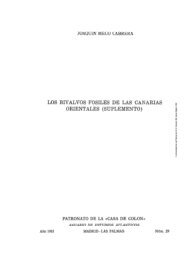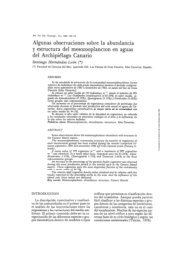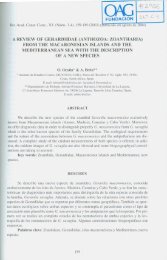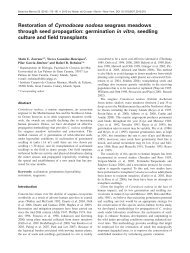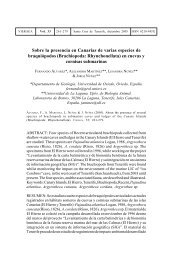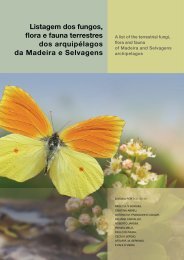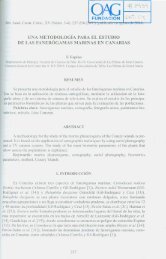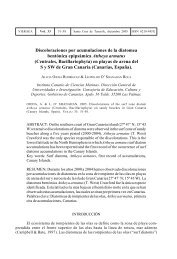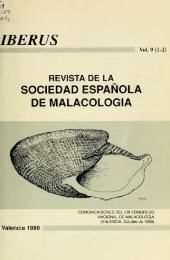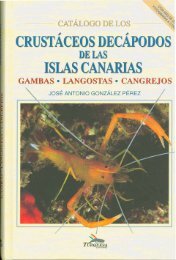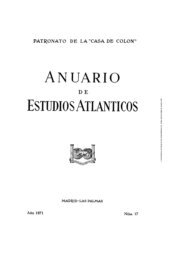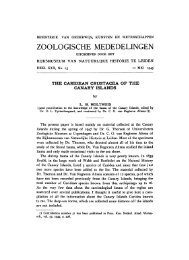Egg development and fecundity estimation in deep-sea red ... - redmic
Egg development and fecundity estimation in deep-sea red ... - redmic
Egg development and fecundity estimation in deep-sea red ... - redmic
You also want an ePaper? Increase the reach of your titles
YUMPU automatically turns print PDFs into web optimized ePapers that Google loves.
374 V.M. Tuset et al. / Fisheries Re<strong>sea</strong>rch 109 (2011) 373–378<br />
November–December 2006 (n = 21), co<strong>in</strong>cid<strong>in</strong>g with the spawn<strong>in</strong>g<br />
period October–May (López Abellán et al., 2002). Individuals were<br />
recollected us<strong>in</strong>g bottom traps at depths of 600–1000 m (Carvalho<br />
et al., 2007) to the south of Gran Canaria (Canary Isl<strong>and</strong>s, northeastern<br />
Atlantic) (Fig. 1). Only fresh samples, the last day of collect<strong>in</strong>g,<br />
were taken to the laboratory for the posterior study: 14 females<br />
we used for the morphological study of eggs <strong>and</strong> 30 females for the<br />
<strong>fecundity</strong> <strong>estimation</strong>. Carapace width (CW <strong>in</strong> mm) <strong>and</strong> total weight<br />
(TW <strong>in</strong> g) were taken from each crab.<br />
2.2. <strong>Egg</strong> <strong>development</strong><br />
The fresh egg mass was separated from the pleopods, placed on<br />
a mesh of 100 m, <strong>and</strong> washed with <strong>sea</strong>water under pressure to<br />
detach all the eggs. Then some eggs were placed <strong>in</strong> two Petri dishes<br />
with <strong>sea</strong>water under a compound microscope with reflected light.<br />
Four images for each Petri dish (one by quadrant) were taken <strong>in</strong><br />
each female with a digital video camera (Basler A310, Vision Technologies,<br />
Basler AG, Ahrensburg) for the automated morphology<br />
analysis (Fig. 2). Approximately, 40 eggs were measu<strong>red</strong> <strong>in</strong> each<br />
quadrant. Image-Pro Plus version 4.1.0 software (Media Cybernetics,<br />
Inc.) was used to calculate the follow<strong>in</strong>g shape parameters <strong>and</strong><br />
<strong>in</strong>dices: projected area (A <strong>in</strong> mm 2 ), maximum diameter (D <strong>in</strong> mm),<br />
m<strong>in</strong>imum diameter (d <strong>in</strong> mm), roundness (4A/( D 2 )), <strong>and</strong> aspect<br />
ratio (D/d)(Russ, 1990). <strong>Egg</strong> morphology was described <strong>and</strong> classified<br />
accord<strong>in</strong>g to Arshad et al. (2006) <strong>and</strong> Walker et al. (2006) for<br />
other brachyuran crabs, <strong>and</strong> colour changes of the egg mass consider<strong>in</strong>g<br />
previous studies <strong>in</strong> Chaceon spp. (Wigley et al., 1975; Haefner,<br />
1978).<br />
2.3. Estimation of <strong>fecundity</strong><br />
The gravimetric method was applied to determ<strong>in</strong>e <strong>fecundity</strong><br />
(AFE, annual <strong>fecundity</strong> <strong>estimation</strong>), which was def<strong>in</strong>ed as annual<br />
egg production, consider<strong>in</strong>g that spawn<strong>in</strong>g might occur only once<br />
a year, us<strong>in</strong>g a subsample of 5% by wet weight of the egg mass<br />
(Lowerre-Barbieri <strong>and</strong> Barbieri, 1993). Two methodological procedures<br />
were applied: (a) <strong>in</strong> method 1 (February–March sample), the<br />
fresh egg mass was separated from the pleopods, placed on a mesh<br />
of 100 m, <strong>and</strong> washed with <strong>sea</strong>water under pressure to detach all<br />
the eggs. Then the eggs were placed <strong>in</strong> Petri dishes with <strong>sea</strong>water<br />
Fig. 1. Location of the study area.<br />
under a compound microscope with reflected light, to count the<br />
eggs us<strong>in</strong>g a h<strong>and</strong> counter. (b) In method 2 (November–December<br />
sample), fresh egg masses were sto<strong>red</strong> <strong>in</strong> 4% buffe<strong>red</strong> formal<strong>in</strong>,<br />
detached from the pleopod filaments us<strong>in</strong>g tweezers, placed on<br />
Fig. 2. Digitalized image of eggs for morphological analysis: (A) orig<strong>in</strong>al image; (B)<br />
modified b<strong>in</strong>ary image.



